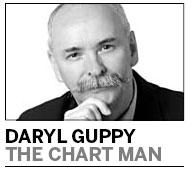Daryl Guppy
Regulation - the new trade risk factor
By Daryl Guppy (China Daily)
Updated: 2011-05-09 11:26
 |
Large Medium Small |

The collapse in the price of silver from $49 to below $39 is a harbinger of collapses among a wider range of commodity prices. It is the end of speculative bubbles that have been building for several months. The collapse is not brought about by a sudden return to the fundamentals of supply and demand. It is triggered by changes to the way the trade is executed. This is regulatory risk in action.
One month ago in this column we discussed the growing regulatory risk that threatened commodity markets. The risk was hinted at in an April speech by Federal Reserve Chairman Ben Bernanke, with his focus on clearing and settlement issues.
The last great bull run in silver, when the Hunt brothers tried to corner the market, was halted in the same way. The 1980 speculative bubble in silver collapsed when COMEX changed the future contract margin requirements from 10 percent to as high as 100 percent. Traders had to come up with more money to finance each current and new trade and this caused the market to collapse.
This type of regulatory change, or the threat of regulatory change, destroyed the speculative bull run in oil in 2007. We noted in the April column that this had the potential to do the same to the increasingly speculative bull run in silver and gold.
Last week saw multiple rises in the margin required for silver trades. Traders with open positions had to come up with increasing amounts of cash to keep the position open. These margin calls made it more difficult for traders to fund their positions. Many had little option but to sell, and their selling cascaded through the silver market, crashing prices to below $39.
This has two important consequences for commodity markets. First is the fear of contagion. If the clearing houses were prepared to rapidly and dramatically increase margin requirements in silver, how long would it be before they applied similar requirements to hot commodities such as gold, oil and copper? It might not happen, but the fear of this type of regulatory adjustment sent a contagion shiver through commodity speculators. The sell-off started and gathered rapid momentum plunging gold to below $1,480.
The second important consequence comes from the Exchange-Traded Commodity Funds (ETCFs). These funds are either based in futures and derivatives contracts or they hold the physical commodity. Their trading activity is dictated by the demands of their investors. It is not driven by demand and supply of the commodity.
When their investors have confidence in the commodity price they buy more of the ETCFs, which in turn forces the fund to buy more in the commodity market. This buying helps support prices and to continue the upward-trend pressure. When these ETCF investors decide it is too dangerous in the commodity market, they will issue sell orders to the ETCF. The ETCF must sell to meet investor redemptions. Nothings spreads fear more quickly than a stampede of investor speculators as they head for the exit.
The combined effect of multiple increases in margins and a dramatic increase in demand to exit the ETCF - causing them to sell - act together to develop powerful selling pressure. This takes the speculative air out of the bubble in commodity prices and drops the price back to a closer alignment with demand and supply.
But it all begs an important question. There is no conspiracy to lift the margin requirement for silver. The clearing houses have a commercial and business agenda. They must be confident that their clients can fund the increasingly expensive positions. Increasing the margin is prudent business practice.
However, some traders are asking if this is not also similar to market manipulation, where prices are affected by the activity of participants to achieve a desired effect. They argue that a gradual increase in margin is fair and reasonable, but the multiple increases in margin requirements over the last seven days smacks of a more active intervention in the market in a way designed to affect prices.
The parabolic trend pattern that developed in silver confirmed the development of a speculative market. It also indicated a sudden and dramatic price collapse at the end of the parabolic trend. And just as with the parabolic trend in oil in 2007, the collapse of the trend was triggered by an event external to the fundamentals of the market. Regulatory risk where the mechanics of the trade are changed is again confirmed as a significant new risk factor in trading.
The author is a well-known international financial technical analysis expert.
| 分享按鈕 |